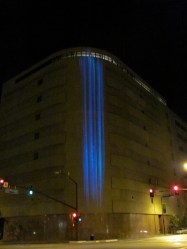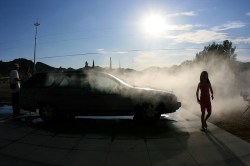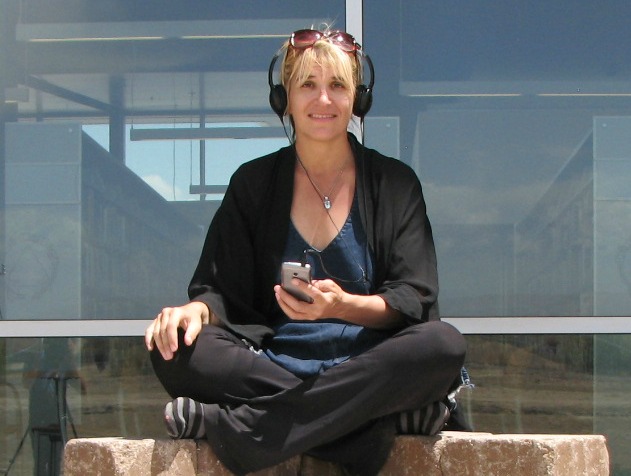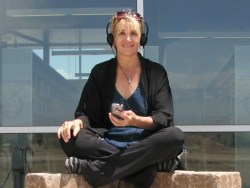Andrea Polli is what you might call a climate artist.
Where scientists mine data for evidence supporting or refuting their hypotheses, Polli looks at the same information and sees the potential for beauty. With degrees in both fine arts and computing, Polli works somewhere at the intersection of science, technology, art, and media. She translates raw data into sensory experience — producing sonifications of Antarctic weather patterns and visualizations of stock-market activity; digital projections of particulate air pollution and interactive maps of sound in New York City — like an audio version of Googlemaps’ Street view.
Polli has spent time everywhere from Antarctica to New Zealand to Taiwan, and is currently a professor in the University of New Mexico’s Art and Ecology program.
We caught up with Polli recently and talked about chaos theory, the sounds of climate change, and her artistic version of slow food.
Q. What led you to do the kind of work you’re doing now?
A. I had been working with computers all my life and creating little programs. But I never really thought of it as art until I went to grad school at the Art Institute of Chicago, and I had a mentor who caught me in the computer lab late at night and said, “What are you doing? Why haven’t we seen this stuff?”
A big article came out in Scientific American in ’85, and it had code in it. So me and my friends were typing in the code and programming these fractals. I started programming chaotic attractors to create algorithmic music: I was looking at these beautiful images of the butterfly attractor, and I thought, wow, this is just a mathematical formula and it makes this beautiful image — I wonder if it would make beautiful music.
Q. How did you start focusing on climate science?

Andrea PolliParticle Falls represents particulate pollution in Santa Clara County, Calif.
A. The butterfly attractor and other chaotic attractors are actually models of air moving through the atmosphere. Around 2000, I went on an art-science conference workshop, and met a meteorologist there. He said we could model something that happens historically almost exactly — like a hurricane or a snowstorm. That led me to wonder what that might sound like. So we did the piece Atmospherics/Weather Works, which was a 16-channel sonification of a hurricane and a winter snow storm. The storm data created sound that was really dramatic, and I thought, well, would climate data create a kind of ambient sound?
[I was connected] with Cynthia Rosenzweig, who runs the climate research group at the NASA Goddard Institute [for Space Studies] up at Columbia. She’s being a scientist, very careful about what she says, and she starts telling me things that were really shocking. It made me really amazed at what was happening with climate change. So we did a project together called Heat and the Heartbeat of the City that used the climate models of their group. That’s really when I think I started to become actively involved in trying to address this issue of climate change however I could.
Q. How has your approach to climate change in your art changed as the warnings from scientists have gotten increasingly dire?
A. At first I was just aesthetically exploring these things. A piece about climate predictions in New York City or a piece about the weather in the North Pole inherently has some content about climate change. But I’ve started to do more pieces that really start to give people information about what you can do to change your behavior or help [address] this.
Q. Do you intend for your work to have a practical application?
A. I’m interested in ambient data — I like to call it slow visualization, like slow food. You live with it, and you’re getting information, but you’re not necessarily attending to that information all the time. I think my sonification work functions like that. It’s an ambient soundscape that you don’t have to give 100 percent of your attention to, but it’s sort of present.
Q. Environmentalists are constantly talking about how to make climate science accessible to the general population — how to get the message across that there is scientific consensus on this urgent issue. How does your work, or art in general, further that goal?

Andrea PolliCloud Car explores the connection between life, the automobile, and air in New York City.
A. When you’re hearing things about climate change all the time, you just get tired of it and you can’t keep responding. I think that’s the thing about people making interesting artwork; it keeps some of these ideas fresh and offers new solutions and new ideas. It helps people have access to the data and start to understand it. I think it touches [people on] an emotional level. These artworks that I’m doing, and other people are doing, interpreting data — compared to looking at a spreadsheet or bar chart, it’s a lot more emotional.
What we’re dealing with, with climate change, is so big that whatever people come to the table with, you need to bring those [skills]. Artists can have an impact, and designers, and journalists. It’s all hands on deck.
Q. What are you working on now?
A. I’m in [Greensboro, N.C.], doing a residency with this amazing place. A woman collected things for 70 years, and now they’ve turned it into a museum and artists’ residency, and it’s all about reusing materials.
I’m working with an engineering professor at the University of New Mexico. She creates these energy harvesters that will harvest energy from wifi in the air and other radio signals and television signals. We’re working on ways to visually emphasize the energy and use it to create something beautiful. That project just started.
I run a research lab called the Social Media Workgroup at the university. We just did a project called The Bioethics of Beer. We brewed beer as sustainably as possible, we used solar ovens to roast the grain and boil water, and we ground the grain using this bicycle-powered thing that we created.
Oh, and I’m a professor in this new art and ecology program. We collaborate with biology and engineering and sustainability studies. It’s very much the students engaging mostly with the environment of the Southwest, but we’ve also had projects in Australia and all over the place. It’s very field-based, actually building things that create change.
Q. What kinds of things are students in the program creating?
A. One project that I thought was really smart and controversial: Our campus is like a beautifully landscaped garden. A team of students researched all the plants on campus that were edible, and did a tour of what you can eat on campus. However, because the campus uses pesticides, you can’t eat anything on campus. So it was a tour saying what might be possible if we stopped using these pesticides. Hopefully that will have an impact on the kind of landscaping that happens on campus.
Q. Out of all the work you’ve done, which projects stand out as particularly memorable?
A. We collaborated with two Navajo artists and did a piece called Binding Sky. It’s a tour through the Navajo Nation in an area where there’s two of the largest coal-fired power plants in the country. They’re flanking a really sacred site, the site of Shiprock. We did an Android app that’s an audio tour through that place. We interviewed experts and activists. That was a really incredible experience, to work with the Navajo Nation. I’m hoping to do more of that in the future.





